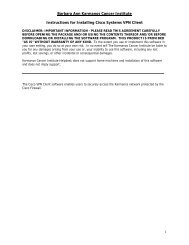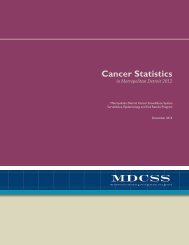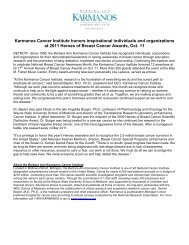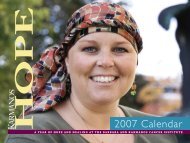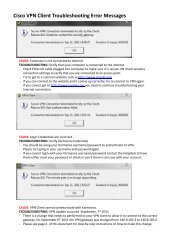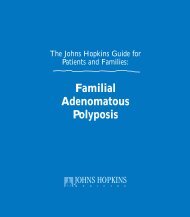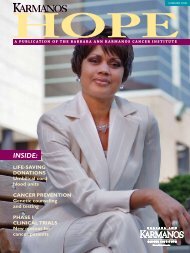Environmental exposure to Libby asbestos and mesotheliomas
Environmental exposure to Libby asbestos and mesotheliomas
Environmental exposure to Libby asbestos and mesotheliomas
Create successful ePaper yourself
Turn your PDF publications into a flip-book with our unique Google optimized e-Paper software.
AMERICAN JOURNAL OF INDUSTRIAL MEDICINE (2008)<br />
Brief Report<br />
<strong>Environmental</strong> Exposure <strong>to</strong> <strong>Libby</strong> Asbes<strong>to</strong>s<br />
<strong>and</strong> Mesotheliomas<br />
Alan C. Whitehouse, MD, FCCP, 1 C. Bradford Black, MD, 1 Mark S. Heppe, MD, 1<br />
John Ruckdeschel, MD, 2 <strong>and</strong> Stephen M. Levin 3{<br />
Background Thirty-one cases of mesothelioma resulting from <strong>exposure</strong> <strong>to</strong> <strong>Libby</strong> Asbes<strong>to</strong>s<br />
have been identified from <strong>Libby</strong>, Montana. Eleven cases not previously reported are the<br />
subject of this report.<br />
Methods These cases are in non-occupationally exposed people, appearing <strong>to</strong> have<br />
resulted from <strong>exposure</strong> <strong>to</strong> contamination of the community, the surrounding forested area,<br />
<strong>and</strong> areas in proximity <strong>to</strong> the Kootenai river <strong>and</strong> railroad tracks used <strong>to</strong> haul vermiculite.<br />
Results These <strong>exposure</strong>s are considered <strong>to</strong> be of a low degree of magnitude, but are similar<br />
<strong>to</strong> those in Western Australia’s crocidolite mine at Wittenoom Gorge. An epidemic of<br />
mesothelioma can likely be expected from this type of asbes<strong>to</strong>s contamination over the next<br />
20 plus years. Am. J. Ind. Med. 2008. ß 2008 Wiley-Liss, Inc.<br />
KEY WORDS: tremolite; winchite; richterite; mesothelioma; asbes<strong>to</strong>s;<br />
pleural cancer; asbes<strong>to</strong>s pleural disease; vermiculite; <strong>Libby</strong><br />
INTRODUCTION<br />
McDonald et al. [2004] described 12 confirmed cases of<br />
mesothelioma occurring before 1998 in former employees of<br />
the W.R. Grace Company (WRG). The company operated the<br />
world’s largest vermiculite mine near <strong>Libby</strong>, MT, from 1963<br />
<strong>to</strong> 1990. The mine was operated by the original Zonolite<br />
Corporation from the 1920s until purchased by W.R. Grace in<br />
1963. The vermiculite ore bed was contaminated with up <strong>to</strong><br />
‘‘Dr. Alan Whitehouse has served as an expert witness in United States v.WR Grace <strong>and</strong><br />
related Bankruptcy Proceedings.’’<br />
1 Center forAsbes<strong>to</strong>s Related Disease, <strong>Libby</strong>, Montana<br />
2 Barbara Ann Karmanos Cancer Institute, Detroit, Michigan<br />
3 Department of Community <strong>and</strong> Preventive Medicine, Mount Sinai School of Medicine,<br />
New York, New York<br />
{ Associate Professor.<br />
Contract grant sponsor: CDC; Contract grant number: 875; Contract grant sponsor: CCH;<br />
Contract grant number: 524709-01.<br />
*Correspondence <strong>to</strong>: Alan C.Whitehouse, 123 e 3rd, <strong>Libby</strong>, MT 59923.<br />
E-mail: alanwhitehouse47@gmail.com<br />
Accepted12 June 2008<br />
DOI10.1002/ajim.20620. Published online in Wiley InterScience<br />
(www.interscience.wiley.com)<br />
26% amphibole asbes<strong>to</strong>s, originally believed <strong>to</strong> be tremolite;<br />
but more recent analysis indicates the asbes<strong>to</strong>s is a<br />
combination of 84% winchite, 11% richterite <strong>and</strong> 6%<br />
tremolite [Meeker et al., 2003]. Agency for Toxic Substances<br />
<strong>and</strong> Disease Registry (ATSDR) documents confirmed<br />
contamination of the <strong>to</strong>wn of <strong>Libby</strong>, MT, along the Kootenai<br />
River <strong>and</strong> the surrounding environment [ATSDR, 2000].<br />
Vermiculite ore was given by WRG free of charge <strong>to</strong> the<br />
people of <strong>Libby</strong> <strong>and</strong> was extensively used in gardens,<br />
driveways, little league ball fields, <strong>and</strong> the high school track.<br />
Exp<strong>and</strong>ed vermiculite (Zonolite) insulation was used<br />
extensively in the lumber mill. Many attics <strong>and</strong> walls of<br />
homes in <strong>Libby</strong> are insulated with vermiculite. The finished<br />
vermiculite product contains 2–6% asbes<strong>to</strong>s [Am<strong>and</strong>us<br />
et al., 1987]. Cases of pleural disease among people exposed<br />
only environmentally (non-occupationally) have been documented<br />
previously by ATSDR [2002]. <strong>Environmental</strong> levels<br />
of asbes<strong>to</strong>s recorded by WRG in 1975 ranged from 1.0 <strong>to</strong><br />
1.5 fibers/ml air, [Grace, 1975]. Sullivan [2007] reported that<br />
15 cases of mesothelioma were documented in WRG<br />
workers as of 2001. We report an additional 11 cases of<br />
mesothelioma that have been documented among nonoccupationally<br />
exposed people by the Center for Asbes<strong>to</strong>s<br />
Related Disease (CARD) in <strong>Libby</strong>.<br />
ß 2008 Wiley-Liss, Inc.
2 Whitehouse et al.<br />
METHODS<br />
The Center for Asbes<strong>to</strong>s Related Disease in <strong>Libby</strong>, MT,<br />
serves as a focal point for diagnosis <strong>and</strong> treatment of<br />
asbes<strong>to</strong>s-related diseases in the region. CARD has become<br />
aware of 15 cases of malignant mesothelioma since 1995 that<br />
were not included in the studies by McDonald et al. <strong>and</strong><br />
Sullivan noted above. These cases include four WRG<br />
employees (details not reported here), two family members<br />
of WRG workers <strong>and</strong> nine purely environmental cases among<br />
<strong>Libby</strong> residents. The two family cases <strong>and</strong> nine environmental<br />
cases have appeared since 1995 <strong>and</strong> were treated at<br />
the CARD clinic or by one of the coauthors of this report. The<br />
additional four cases were reported <strong>to</strong> the authors by current<br />
or former residents of <strong>Libby</strong>. Occupational <strong>and</strong> environmental<br />
<strong>exposure</strong> his<strong>to</strong>ries were obtained from the patients<br />
<strong>and</strong> CARD records <strong>and</strong> supplemented by next-of-kin. The<br />
<strong>exposure</strong> his<strong>to</strong>ry of Case 5 was obtained from the patient’s<br />
widow only. Family physicians were contacted <strong>to</strong> obtain<br />
pathology reports, death certificates <strong>and</strong> any other<br />
pertinent information that was not available at CARD.<br />
Pathology reports of biopsies were obtained on all subjects<br />
except one case.<br />
RESULTS<br />
The details regarding the clinical <strong>and</strong> <strong>exposure</strong> status of<br />
the two family contact cases <strong>and</strong> nine environmental<br />
<strong>exposure</strong> cases are described below <strong>and</strong> in Table I.<br />
Case 1: This 65-year-old male lived in <strong>Libby</strong> from 1941<br />
<strong>to</strong> 1959. His father worked at the Zonolite facility throughout<br />
that time period. He also had possible <strong>exposure</strong> <strong>to</strong> asbes<strong>to</strong>s as<br />
a construction worker for many years, but worked mainly in<br />
residential construction <strong>and</strong> was uncertain about the extent of<br />
contact with asbes<strong>to</strong>s-containing materials on the job.<br />
Zonolite was used in the garden <strong>and</strong> attic of his childhood<br />
home in <strong>Libby</strong>. His mesothelioma was diagnosed in 2006. He<br />
is alive as of this writing.<br />
Case 2: A 52-year-old woman died in 2003 of peri<strong>to</strong>neal<br />
mesothelioma diagnosed in 2000. She was employed at a<br />
private medical <strong>and</strong> dental office in <strong>Libby</strong> from 1971 <strong>to</strong><br />
1983. She reported that her car was covered with dust on a<br />
daily basis after work. Her workplace was 5 miles southwest<br />
of the WRG mine <strong>and</strong> 1 mile north of <strong>Libby</strong>. Many of the<br />
patients where she worked were WRG employees who were<br />
seen after a work shift. She had no other known <strong>exposure</strong> <strong>to</strong><br />
asbes<strong>to</strong>s.<br />
TABLE I. Exposure <strong>and</strong> Pathology Data on11Cases of Mesothelioma,<strong>Libby</strong>,Montana<br />
Case<br />
number<br />
Sex<br />
Age/year at<br />
diagnosis<br />
Year of<br />
death<br />
Year of<br />
initial<br />
<strong>exposure</strong><br />
Number<br />
of years<br />
since<br />
initial<br />
<strong>exposure</strong><br />
Calendar<br />
years of<br />
<strong>exposure</strong><br />
(years)<br />
Durationof<br />
<strong>exposure</strong><br />
(years)<br />
Source(s)<br />
of<strong>exposure</strong><br />
Pathology a<br />
1 M 65/2006 Alive 1941 65 1941^1959 18 Resident/Family/ Epithelial<br />
Construction<br />
trades<br />
2 F 52/2000 2003 1971 29 1971^1985 17 Resident Epithelial(p)<br />
3 M 71/1993 1995 1980 13 1980^1986 6 Resident<br />
b<br />
4 F 48/1999 2000 1963 36 1963^1965 2 Family/Aluminum<br />
Plant<br />
Epithelial<br />
5 M 81/2003 2004 1960 44 1960^unknown,<br />
1994^2004<br />
10þ<br />
Resident/Recreation/<br />
US Coast Guard/<br />
Carpenter<br />
Epithelial<br />
6 F 48/1996 1998 1944 52 1944^1998 54 Resident Epithelial<br />
7 M 70/1998 1998 1945 67 1931^1998 67 Resident Epithelial<br />
8 M 82/2002 2002 1960 42 1960^1970 10 Resident Epithelial<br />
9 F 59/1995 Alive 1973 22 1973^2007 34 Resident Epithelial<br />
10 F 79/2002 2002 1950 52 1950^2002 52 Resident Epithelial<br />
11 M 72/2000 2002 1968 34 1968^1976,<br />
1984^2002<br />
26 Resident Epithelial<br />
a All were pleural mesothelioma except # 2 (peri<strong>to</strong>neal mesothelioma).<br />
b Not available due <strong>to</strong>13 years hiatus since death.
<strong>Libby</strong> Asbes<strong>to</strong>s <strong>and</strong> Mesotheliomas 3<br />
Case 3: This 71-year-old male was diagnosed with<br />
mesothelioma in 1993 <strong>and</strong> died of the disease in 1995. He<br />
lived in <strong>Libby</strong> for 6 years from 1980 <strong>to</strong> 1986. He had one<br />
guided <strong>to</strong>ur of the WRG mine, but otherwise had no other<br />
known <strong>exposure</strong> <strong>to</strong> asbes<strong>to</strong>s other than by virtue of his<br />
residence in <strong>Libby</strong>. He was an office employee of the forest<br />
service, <strong>and</strong> his father did not live or work in <strong>Libby</strong>, His wife<br />
has asbes<strong>to</strong>s-related pleural disease, again following only<br />
residential <strong>exposure</strong>. His personal physician provided<br />
medical records documenting the diagnosis, but the original<br />
pathology report was lost so the cell type could not be<br />
determined.<br />
Case 4: This female died in 2000 at the age of 49 of<br />
mesothelioma diagnosed in 1999. She lived approximately 100<br />
miles east of <strong>Libby</strong>. Her father worked at the Zonolite mine<br />
from 1963 <strong>to</strong> 1965 <strong>and</strong> came home on weekends, when the<br />
patient laundered his work clothes. Her father also worked<br />
intermittently at an aluminum plant in Columbia Falls, MT,<br />
which may have entailed <strong>exposure</strong> <strong>to</strong> asbes<strong>to</strong>s.<br />
Case 5: This elderly male was age 81 at the time of his<br />
diagnosis. The patient lived in eastern Washing<strong>to</strong>n <strong>and</strong><br />
vacationed in <strong>Libby</strong> nearly every summer in the 1960s <strong>to</strong><br />
fish on the Kootenai River downstream a short distance<br />
from the vermiculitethe vermiculite transfer site: the WRG<br />
conveyor extending across the river from the screening<br />
plant <strong>to</strong> the rail loading yards. He ultimately moved <strong>to</strong><br />
<strong>Libby</strong> in the mid-1990. The diagnosis of mesothelioma<br />
wasmadein2003,<strong>and</strong>hediedin2004.Healsomay<br />
have had <strong>exposure</strong> <strong>to</strong> asbes<strong>to</strong>s in the U S Coast Guard at the<br />
endofWWII.Asalifelongcarpenter,heislikely<strong>to</strong>have<br />
had <strong>exposure</strong> <strong>to</strong> asbes<strong>to</strong>s in his work. Relevant <strong>to</strong> his<br />
<strong>exposure</strong> in <strong>Libby</strong>, it is of use <strong>to</strong> note his widow has<br />
developed diffuse calcified pleural thickening <strong>and</strong> had no<br />
identifiable <strong>exposure</strong> <strong>to</strong> asbes<strong>to</strong>s except during her<br />
residence in <strong>Libby</strong>.<br />
Case 6: A 48-year-old woman who lived lifelong in<br />
<strong>Libby</strong> died in 1998 of mesothelioma, diagnosed 2 years<br />
previously. She lived near the contaminated ball fields <strong>and</strong><br />
railroad tracks, played as a child on piles of vermiculite ore,<br />
<strong>and</strong> popped vermiculite on the s<strong>to</strong>ve. Zonolite insulation was<br />
in the ceiling of the home where she lived during the last<br />
25 years of her life.<br />
Case 7: This was a male who was diagnosed at age 68<br />
<strong>and</strong> died at age 70 in 1998. He worked for the railroad, sealing<br />
railcars leaving Zonolite facilities in 1945 <strong>and</strong> 1946. He lived<br />
next <strong>to</strong> the expansion plant from 1954 <strong>to</strong> 1956 <strong>and</strong> had<br />
Zonolite in the garden <strong>and</strong> attic. From 1976 <strong>to</strong> 1981, he<br />
worked in a bowling alley, which WRG workers frequented<br />
after work.<br />
Cases 8: This elderly man was diagnosed <strong>and</strong> died of<br />
mesothelioma in 2002, at age 82. He lived in <strong>Libby</strong> for<br />
10 years from the early 1960s, across the Kootenai River<br />
from the expansion <strong>and</strong> bagging plant. He had no other<br />
known <strong>exposure</strong> <strong>to</strong> asbes<strong>to</strong>s.<br />
Case 9: This 71-year-old female was diagnosed with<br />
mesothelioma in 1995 <strong>and</strong> re-biopsied in 2002 <strong>to</strong> confirm the<br />
diagnosis because of unusually long survival <strong>and</strong> responsiveness<br />
<strong>to</strong> chemotherapy. She remains alive in 2007. She lived<br />
40 miles outside of <strong>Libby</strong>, but shopped in <strong>Libby</strong> <strong>and</strong> came<br />
in<strong>to</strong> <strong>to</strong>wn frequently from 1973 <strong>to</strong> 1987. She spent<br />
approximately 300 days in <strong>Libby</strong> during that period. She<br />
had no other identifiable <strong>exposure</strong> <strong>to</strong> asbes<strong>to</strong>s.<br />
Case 10: A 79-year-old woman, a school nurse, died of<br />
mesothelioma in 2002. She lived in <strong>Libby</strong> from 1950 until her<br />
death. She worked as a school nurse for the school district for<br />
many years. Her husb<strong>and</strong> was a forester who may have been<br />
exposed <strong>to</strong> asbes<strong>to</strong>s.<br />
Case 11: This 72-year-old male lived near <strong>Libby</strong> along<br />
the Kootenai River about 2 miles below the screening plant<br />
<strong>and</strong> conveyor. He worked at <strong>Libby</strong> Dam <strong>and</strong> drove past the<br />
screening plant daily from 1973 <strong>to</strong> 1976. He died of<br />
mesothelioma in 2002. He had no other known <strong>exposure</strong> <strong>to</strong><br />
asbes<strong>to</strong>s.<br />
Table I lists age, <strong>exposure</strong>s, <strong>and</strong> mesothelioma cell type<br />
for each case.<br />
The range of latency of these cases is 13–67 years from<br />
first known <strong>exposure</strong> <strong>to</strong> asbes<strong>to</strong>s in <strong>Libby</strong>. The youngest<br />
patient in this series was 48 years of age at diagnosis.<br />
DISCUSSION<br />
Mesothelioma has been shown <strong>to</strong> occur in family members<br />
of asbes<strong>to</strong>s workers as well as in people living near asbes<strong>to</strong>s<br />
facilities. Wagner et al. [1960] described 33 cases of<br />
mesothelioma in South Africa, 12 of whom appeared <strong>to</strong> be<br />
environmental in origin. Newhouse <strong>and</strong> Thompson [1965]<br />
reported 36 cases of mesothelioma occurring in London in an<br />
area around an asbes<strong>to</strong>s fac<strong>to</strong>ry. By 2002, the Australian<br />
mesothelioma registry documented 203 cases with no known<br />
his<strong>to</strong>ry of asbes<strong>to</strong>s <strong>exposure</strong>; but with very careful his<strong>to</strong>ries, 57<br />
of those were discovered <strong>to</strong> have some his<strong>to</strong>ry of <strong>exposure</strong>.<br />
Nineteen percent of the 203 had no <strong>exposure</strong> his<strong>to</strong>ry that could<br />
be identified [Leigh <strong>and</strong> Driscoll, 2003]. Overall, 81% of the<br />
203 had high asbes<strong>to</strong>s fiber counts in tissue specimens [Leigh<br />
<strong>and</strong> Driscoll, 2003], suggesting prior environmental <strong>exposure</strong>s.<br />
ATSDR has documented environmental <strong>exposure</strong>s causing<br />
asbes<strong>to</strong>s-related pleural disease among <strong>Libby</strong> residents<br />
[ATSDR, 2002]. Cases of mesothelioma attributable <strong>to</strong><br />
environmental <strong>exposure</strong>s in <strong>Libby</strong> have been identified only<br />
since 1995; a considerable period after the severe pleural <strong>and</strong><br />
parenchymal disease secondary <strong>to</strong> asbes<strong>to</strong>s <strong>exposure</strong> was<br />
described in WRG workers [Am<strong>and</strong>us et al., 1987].<br />
The background rate of mesothelioma is described as<br />
1 case per million person years [Roggli et al., 1998]. The<br />
9 environmental <strong>and</strong> 2 household-exposed cases described<br />
herein are in excess of expected, given the population of<br />
Central Lincoln County of 9,521 [Peipins et al., 2003].<br />
Eleven cases is probably an underestimate of the true number
4 Whitehouse et al.<br />
of malignant <strong>mesotheliomas</strong> for many reasons including the<br />
inability <strong>to</strong> follow the many workers on the <strong>Libby</strong> dam<br />
project from 1966 <strong>to</strong> 1974 (1 mile northeast of the mine) who<br />
had had significant <strong>exposure</strong> <strong>and</strong> who had left <strong>Libby</strong> after<br />
completion of the dam, as well as the large numbers of<br />
employees of the lumber mill (approximately 1,200), who<br />
were frequently transi<strong>to</strong>ry workers. For the above reasons<br />
<strong>and</strong> the failure <strong>to</strong> learn of all mesothelioma cases in people<br />
who left <strong>Libby</strong>, mesothelioma rates based on currently<br />
identified cases can only be considered an underestimate.<br />
The closest comparison <strong>to</strong> the <strong>Libby</strong> setting is the<br />
mesothelioma experience of the Wittenoom Gorge crocidolite<br />
mine in Western Australia. The blue asbes<strong>to</strong>s mine operated<br />
from 1943 <strong>to</strong> 1966. As of 2002, 254 cases of mesothelioma have<br />
been reported in mine workers <strong>and</strong> residents of the <strong>to</strong>wn [Reid<br />
et al., 2007]. Sixty-seven cases are reported among Wittenoom<br />
residents who were not miners [Reid et al., 2007], representing<br />
a mix of family <strong>and</strong> residential environmental cases.<br />
The estimated <strong>exposure</strong> for Wittenoom residents was<br />
1.0 fibers/ml in ambient air from 1943 <strong>to</strong> 1957 <strong>and</strong> 0.5 fibers/<br />
ml ambient air in 1996. WRG measured 1.1 fiber/ml at the<br />
hospital in down<strong>to</strong>wn <strong>Libby</strong> <strong>and</strong> 1.5 fibers/ml near the lumber<br />
mill <strong>and</strong> railyards in 1975 [Grace, 1975]. Those levels were<br />
obtained with phase contrast microscopy; no other details are<br />
known. Wittenoom <strong>to</strong>wn <strong>exposure</strong>s appear on the surface <strong>to</strong><br />
be of a similar magnitude as experienced by the 11 recent<br />
cases reported here from <strong>Libby</strong>. Wittenoom mine closed<br />
around 1966, near the time WRG began large scale<br />
production in <strong>Libby</strong> [1963]. Exposure <strong>to</strong> <strong>Libby</strong> asbes<strong>to</strong>s of<br />
unknown magnitude continued past 1990. The latency period<br />
for <strong>mesotheliomas</strong> attributable <strong>to</strong> environmental <strong>exposure</strong>s<br />
in <strong>Libby</strong> has therefore not nearly been completed <strong>and</strong> the<br />
extent of the epidemic of environmental mesothelioma due <strong>to</strong><br />
<strong>exposure</strong>s based at <strong>Libby</strong> will probably not peak for another<br />
10–20 years. This is a public health problem of considerable<br />
magnitude <strong>and</strong> points <strong>to</strong> the need for surveillance <strong>and</strong> early<br />
detection of the disease, in the hope that the mortality from<br />
mesothelioma in <strong>Libby</strong> can be reduced.<br />
REFERENCES<br />
Am<strong>and</strong>us HE, Wheeler R, Jankovich J, Tucker J. 1987. The Morbidity<br />
<strong>and</strong> Mortality of Vermiculite Miners <strong>and</strong> Millers Exposed <strong>to</strong> Tremolite-<br />
Actinolite: Part I <strong>and</strong> II. Am J Ind Med 11:1–26.<br />
Agency for Toxic Substances <strong>and</strong> Disease Registry. 2000. Health<br />
Consultation: <strong>Libby</strong> Asbes<strong>to</strong>s Site. December 12.<br />
Agency for Toxic Substances <strong>and</strong> Disease Registry. 2002. Review of<br />
Asbes<strong>to</strong>s-Related Abnormalities among a Group of Patients from<br />
<strong>Libby</strong>, Montana. Available from National Technical Information<br />
Service, Springfield, Virginia. Request publication number PB02-<br />
107378.<br />
Grace WR. 1975. document, Source Emissions, Results of Surveys<br />
(unpublished).<br />
Leigh J, Driscoll T. 2003. Malignant Mesothelioma in Australia, 1945–<br />
2000. Int J Occup Environ Health 9:206–217.<br />
McDonald JC, McDonald AD. 2004. Mortality in a Cohort of<br />
Vermiculite Miners Exposed <strong>to</strong> Fibrous Amphibole in <strong>Libby</strong>, Montana.<br />
J Occup Environ Med 61:363–366.<br />
Meeker GP, Bern AM, Brownfield IK, et al. 2003. The Composition <strong>and</strong><br />
Morphology of amphiboles from the Rainy Creek complex, near <strong>Libby</strong>,<br />
Montana. Am Mineralogist 88:1955–1969.<br />
Newhouse ML, Thompson H. 1965. Epidemiology of Mesothelial<br />
Tumors in the London Area. Ann NY Acad Sci 132:579–602.<br />
Peipins LA, Lewin M, Campolucci S, Lybarger JA, Miller A, Middle<strong>to</strong>n<br />
D, Weiss C, Spence M, Black B, Kapil V. 2003. Radiographic<br />
abnormalities <strong>and</strong> <strong>exposure</strong> <strong>to</strong> asbes<strong>to</strong>s-contaminated vermiculite in<br />
the Community of <strong>Libby</strong>, Montana, USA. Environ Health Perspect<br />
111:1753–1759.<br />
Reid A, Berry G, de Klerk N, Hansen J, Heyworth J, Ambrosini G,<br />
Fritschi L, Olsen N, Merler E, Musk AW. 2007. Age <strong>and</strong> sex differences<br />
after residential <strong>exposure</strong> <strong>to</strong> blue asbes<strong>to</strong>s (Crocidolite). Chest<br />
131:376–382.<br />
Roggli VL, Oury TD, Moffat EJ. 1998. Malignant mesothelioma in<br />
women. In: Rosen PP, Fechner RE, edi<strong>to</strong>rs. Ana<strong>to</strong>mic pathology, Vol. 2.<br />
Chicago, IL: ASCP Press, pp 147–163.<br />
Sullivan P. 2007. Vermiculite, respira<strong>to</strong>ry disease <strong>and</strong> asbes<strong>to</strong>s <strong>exposure</strong><br />
in <strong>Libby</strong>, Montana: Update of a cohort mortality study. Environ Health<br />
Perspect 115(4):579–585.<br />
Wagner J, Sleggs C, March<strong>and</strong> P. 1960. Diffuse pleural mesothelioma<br />
<strong>and</strong> asbes<strong>to</strong>s <strong>exposure</strong> in the North Western Cape Province. Br J Ind Med<br />
17:260.




